Boost Leak Testing - How and Why
#1
Boost Leak Testing - How and Why
I have been asked to provide a writeup that explains the how and why of boost leak testing. It seems that many are unclear on all the details and rationale of this important test. I attempted to make a comprehensive writeup on the subject, which follows below:
PURPOSE
The quickest way to rob an otherwise healthy turbo engine of performance is to introduce a pressure leak within the intake system. The more complex and segmented the intake system, the greater the statistical possibilities for a leak to occur. One thing Iíve realized in dealing with EVOs is that at least 2/3 of them seem to be running the roads with boost leaks that need attention. Boost leaks tend to go unnoticed until or unless one conducts a boost leak test, which should be done sooner than later. Until the leaks are remedied, there will be some degree of reduced compressor efficiency and power, higher intake air temps, slower spool characteristics, and tuning irregularities. If youíve invested your hard-earned money into upgrading your EVO, you donít want any of this.
Every turbo car owner should test for leaks periodically, and especially after any time a piece of the pressurized area is removed for service, etc. Checking for boost leaks involves a simple pressure test of the intake system. So long as one has access to compressed air source, only a few simple tools are required.
MATERIALS
Compressed air source
Spray bottle with soapy water
Pressure regulator with male and female quick connect fittings
Turbo compressor pressure cap
Means of sealing open lines and fittings (rubber caps, plugs, etc.)
Hairspray (pump bottle)
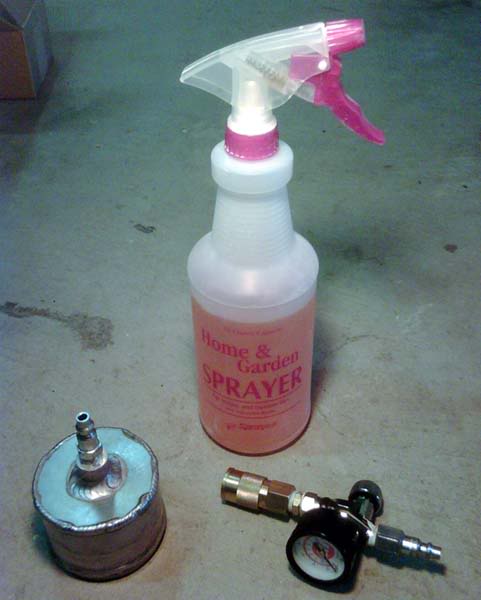
Inexpensive pressure regulator with quick connect fittings - try better auto parts stores
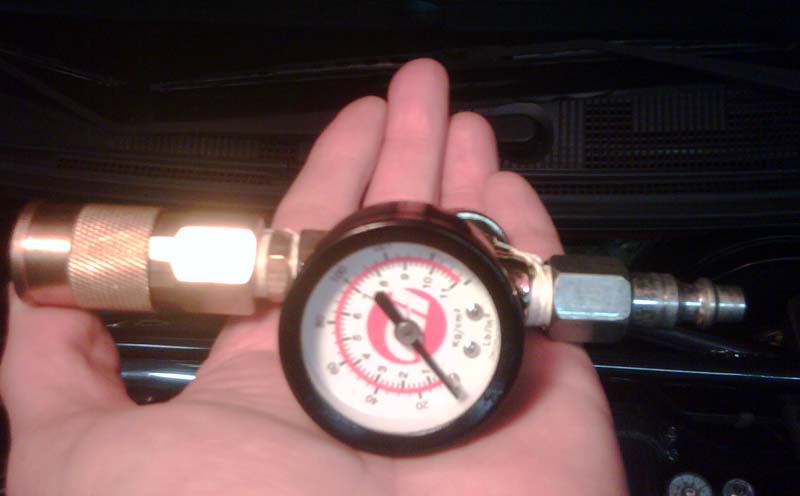
PROCEDURE
Step 1
The entry point of the turbo must be made accessible and pressure tight. This is done by disconnecting part of the intake system from the entrance to the turbo and fitting a short section of silicone adapter tubing to connect the pressure cap to the turbo compressor. Many aftermarket intake systems use a silicone 4Ē-3Ē reducer to connect the intake tubing to the MAF. If you donít already have something like this, get one appropriately sized to fit your turbo.
Silicone reducer (4"-3")
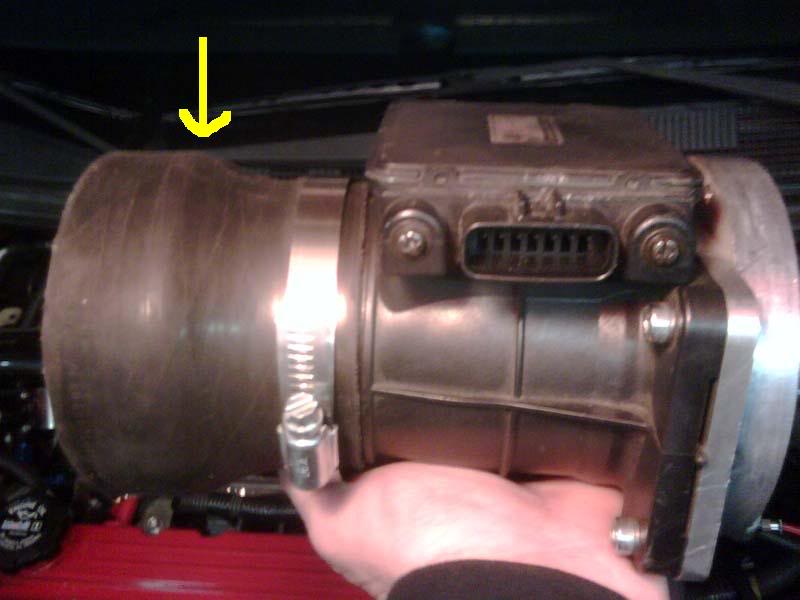
The turbo pressure cap consists of a piece of aluminum tubing with one sealed end. The one Iím using is a 3Ē diameter piece that fits snugly into the silicone adapter. There is a quick connect fitting on the sealed end and a rolled lip on the open end. A good fabricator can put one of these together. The one I am holding in the photo comes from MP Fab.
3" turbo pressure cap
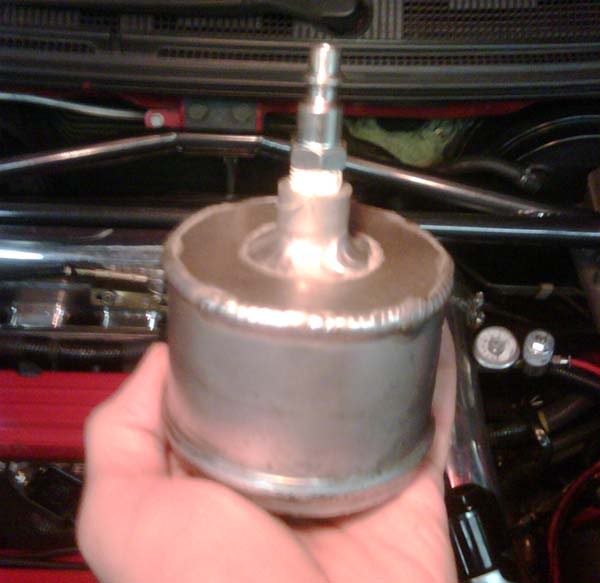
Some turbos do not have a rolled lip at the compressor flange. This usually creates a slippage problem when conducting a boost leak test that results in a loud, startling pop. This can be almost entirely eliminated by applying hairspray around the flange with your finger, and using 2 hose clamps to secure the silicone adapter to the compressor flange. We want to be able to conduct the test with at least the same boost pressure that we expect to use in the real world, and that requires very secure connections.
Turbo connections must be pressure tight. It's not as easy as it seems.
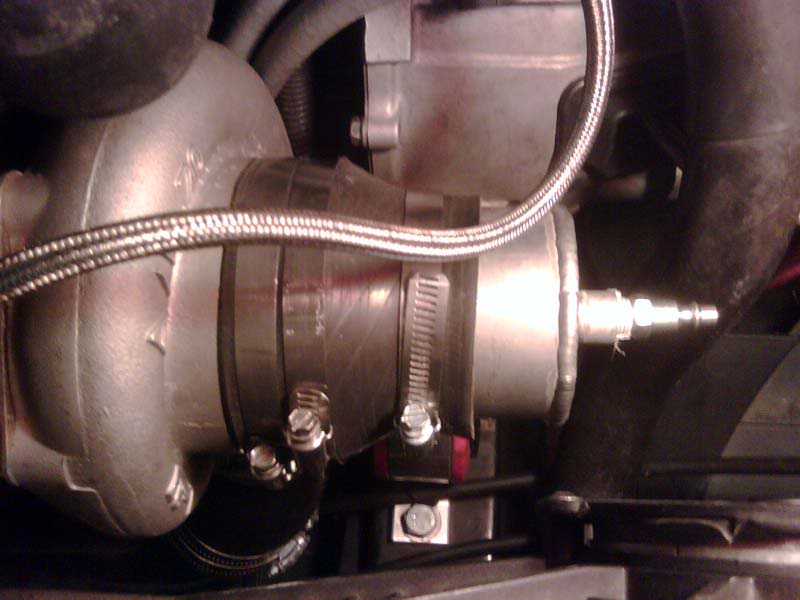
Step 2
You need to trace the intake system from the compressor outlet to the intake manifold, being mindful of any pressure signal taps that lead to something that would bleed air. Be sure you can identify each and every tap into the intake system. If any of these are open-ended, they should be sealed for the test. For example:
- A manual boost controller is effectively a controlled pressure leak. The boost signal line should be disconnected from the manual boost controller and plugged.
- A water or methanol injection system should be fitted with a normally closed solenoid valve in the injection line. If not, there will be an uncontrolled pressure leak that aside from being a source of leakage for the test, can create pump priming issues when the engine is in operation. Be advised.
Solenoid valve - a good idea
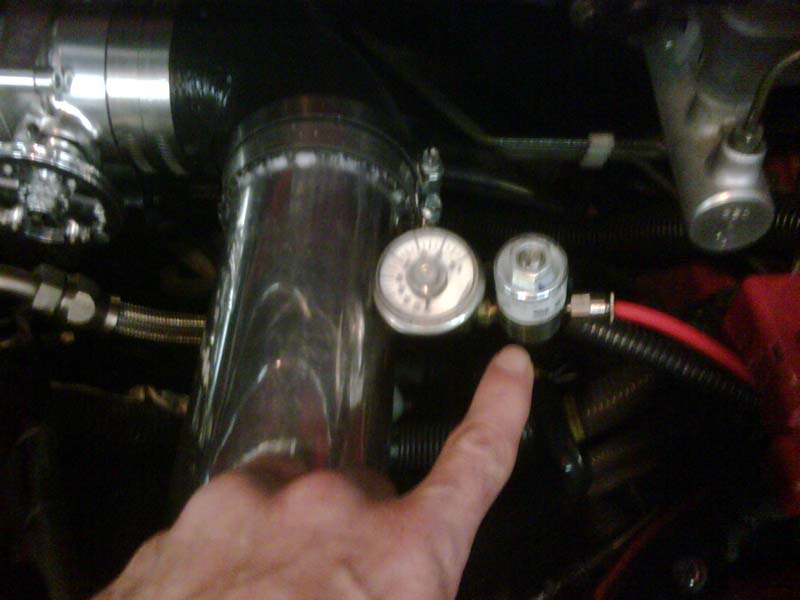
- If there is a recirculating blowoff valve, disconnect the recirculated air line from the valve.
- The PCV valve can be checked by disconnecting the PCV valve from the cam cover itself, leaving the other end connected to the intake manifold.
Anything that bleeds air during a boost leak test also bleeds it under real world conditions, so keep that in mind.
Step 3
With the aforementioned lines sealed and the pressure source connected, we are ready to slowly introduce pressure into the system. Gradually increase the pressure to 20 psi, constantly watching that the silicone adapter is not slipping. If it begins to slip, prepare yourself for a loud, annoying POP!
Be slow with the regulator valve. It takes several seconds to pressurize the system.
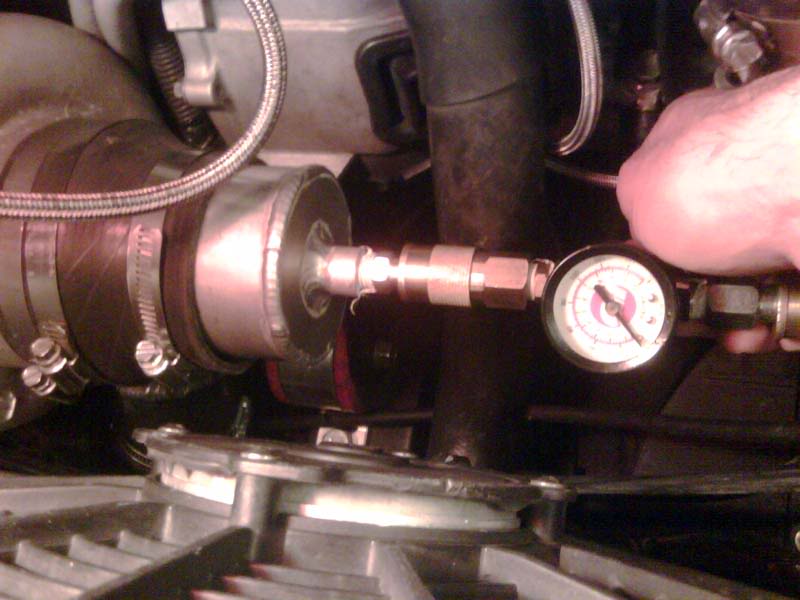
With 20 psi in the system, make the following checks:
- Spray ALL tubing connections while watching for bubbles and listening for hissing. A few tiny, foamy bubbles that slowly seep from joint are acceptable. Larger bubbles that rapidly form and pop are indicative of a leaky joint. Where a leaky joint is discovered, disconnect and carefully reconnect the joint. Doubling the hose clamps is an inexpensive way to make more secure connections at potentially leaky joints. If this is the first time the system is pressure tested, it is wise to get under the car and check the LICP connections. The best way to do this is to conduct the test with the car on a rack with the undertray removed.
Spray all coupler seams.
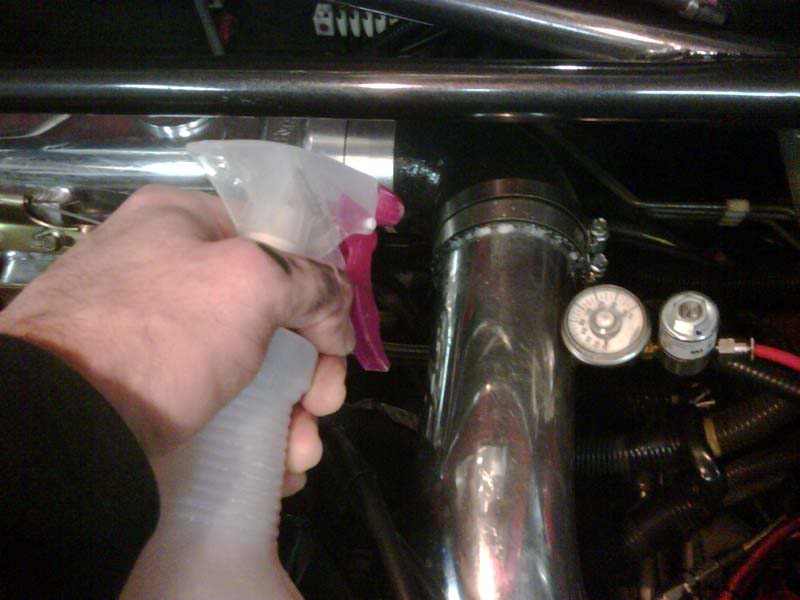
Tiny, slowly oozing bubbles are ok.
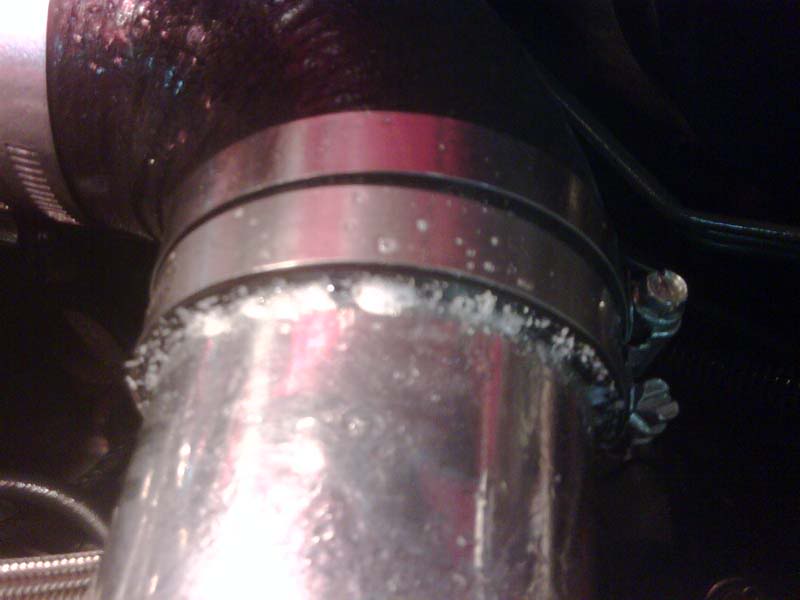
- Spray the IC where the core meets the end tanks. Look for bubbles and listen for hissing. Some IC cores can be leaky, and that is a problem that involves removing the IC and possibly the end tanks to bolster the core end seams with epoxy.
This is easier to do with the front bumper cover off.
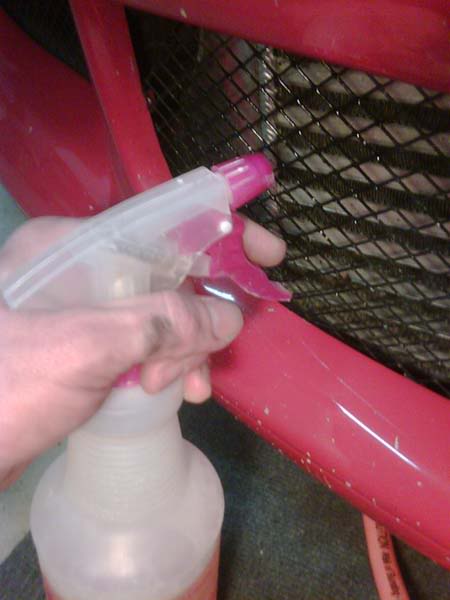
- Run your finger along the backside of the turbo compressor cover. If you feel a jet of air, from either the cover seam or at the head of a cover bolt, be prepared to remove the compressor cover and reaffix with a bead of gasket sealer (e.g. Permatex gray). This is a common problem with newer Garrett turbo covers.
- Check that no air is being vented from the blowoff valve recirculated air line. If there is a leak, the valve needs either adjustment or replacement. If there is a VTA valve, check for a leak at the dump.
No air leak here!
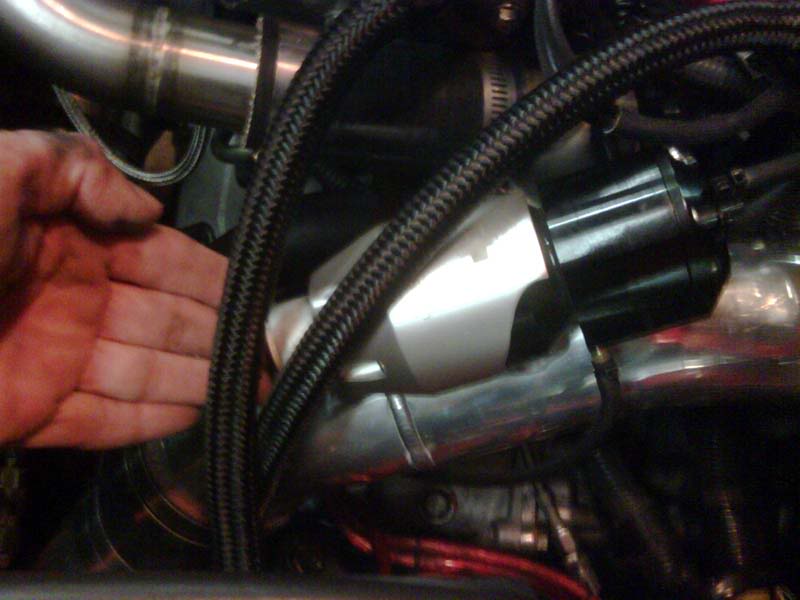
- Check the open cam cover end of the PCV valve and verify that no air is being vented. If there is a leak, replace the PCV valve without delay.
- There may be audible hissing at the throttle body. One cause is air passing through the idle air control valve. That hiss should change in tone or almost disappear if the throttle plate is opened manually.
Hiss is silenced with TB movement
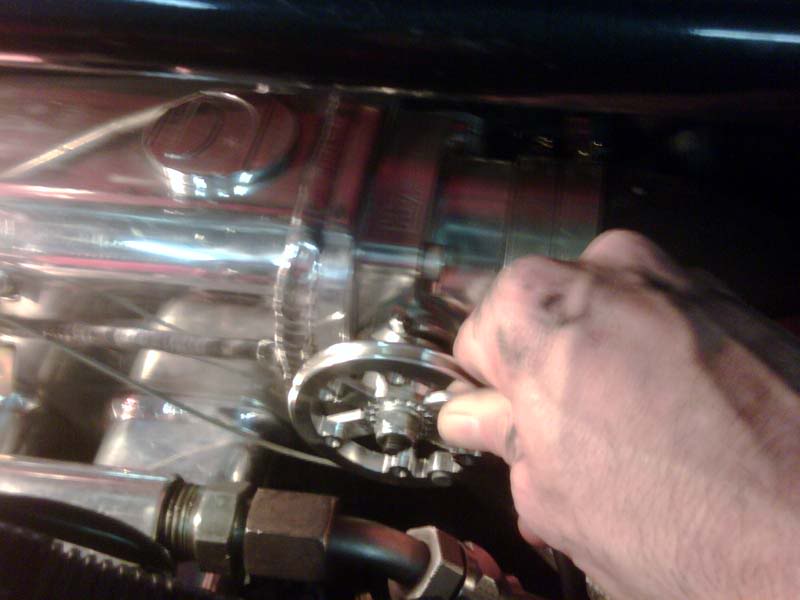
- Check the throttle body shaft ends for air leaks. Itís not easy to get a perfect seal here, but whistling jets of air that blow large bubbles are unacceptable. If it is a well-used factory throttle body, consider replacing the shaft seals.
Check for leaks here.
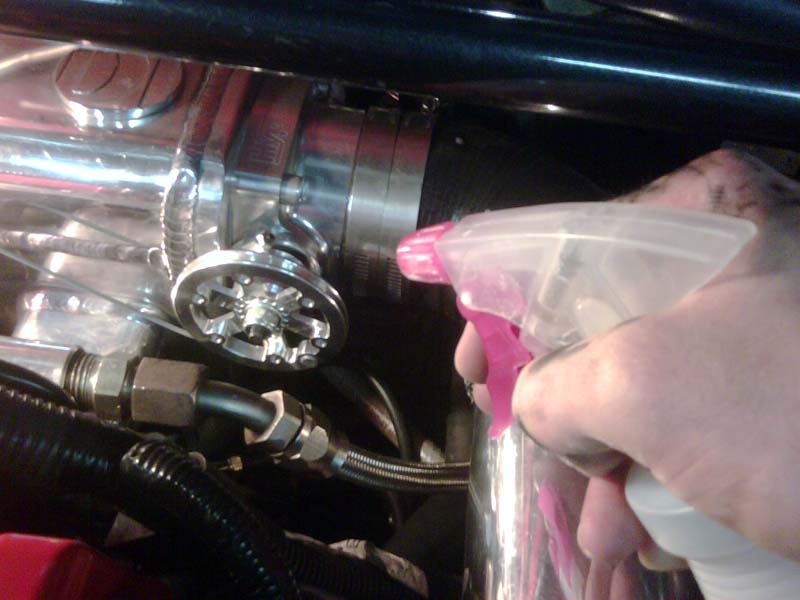
- Check the injector seals for leaks where the injectors mate to the intake manifold runners. A leak at an injector means the o-ring should either be checked and re-seated, or replaced.
Look and listen carefully for leaks here.
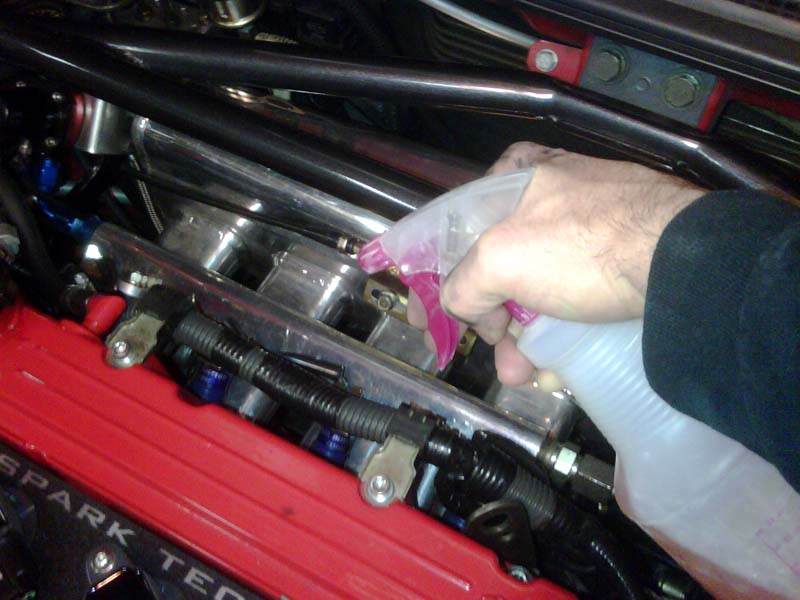
CONCLUSION
When you are satisfied that all is well and any leaks have been fixed, very slowly turn the pressure up to at least the anticipated real world boost pressure level, and listen to all parts of the system carefully for any new sounds or leaks as the pressure rises. Most leaks (especially large ones) are exposed at low pressures, but some donít show up unless there is considerable pressure in the system, which is the worst possible time to have a leak. Make absolutely sure the blowoff valve is air tight at the maximum pressure.
If youíve discovered a large leak or several small leaks, be advised that once they are fixed, you may find that some tuning adjustments may need to be made, especially with mass air systems. This is why it is always best to pressure test your system before the tuning session Ö unless you donít mind taking a chance on having to tune it twice.
Ted B.
PURPOSE
The quickest way to rob an otherwise healthy turbo engine of performance is to introduce a pressure leak within the intake system. The more complex and segmented the intake system, the greater the statistical possibilities for a leak to occur. One thing Iíve realized in dealing with EVOs is that at least 2/3 of them seem to be running the roads with boost leaks that need attention. Boost leaks tend to go unnoticed until or unless one conducts a boost leak test, which should be done sooner than later. Until the leaks are remedied, there will be some degree of reduced compressor efficiency and power, higher intake air temps, slower spool characteristics, and tuning irregularities. If youíve invested your hard-earned money into upgrading your EVO, you donít want any of this.
Every turbo car owner should test for leaks periodically, and especially after any time a piece of the pressurized area is removed for service, etc. Checking for boost leaks involves a simple pressure test of the intake system. So long as one has access to compressed air source, only a few simple tools are required.
MATERIALS
Compressed air source
Spray bottle with soapy water
Pressure regulator with male and female quick connect fittings
Turbo compressor pressure cap
Means of sealing open lines and fittings (rubber caps, plugs, etc.)
Hairspray (pump bottle)

Inexpensive pressure regulator with quick connect fittings - try better auto parts stores

PROCEDURE
Step 1
The entry point of the turbo must be made accessible and pressure tight. This is done by disconnecting part of the intake system from the entrance to the turbo and fitting a short section of silicone adapter tubing to connect the pressure cap to the turbo compressor. Many aftermarket intake systems use a silicone 4Ē-3Ē reducer to connect the intake tubing to the MAF. If you donít already have something like this, get one appropriately sized to fit your turbo.
Silicone reducer (4"-3")

The turbo pressure cap consists of a piece of aluminum tubing with one sealed end. The one Iím using is a 3Ē diameter piece that fits snugly into the silicone adapter. There is a quick connect fitting on the sealed end and a rolled lip on the open end. A good fabricator can put one of these together. The one I am holding in the photo comes from MP Fab.
3" turbo pressure cap

Some turbos do not have a rolled lip at the compressor flange. This usually creates a slippage problem when conducting a boost leak test that results in a loud, startling pop. This can be almost entirely eliminated by applying hairspray around the flange with your finger, and using 2 hose clamps to secure the silicone adapter to the compressor flange. We want to be able to conduct the test with at least the same boost pressure that we expect to use in the real world, and that requires very secure connections.
Turbo connections must be pressure tight. It's not as easy as it seems.

Step 2
You need to trace the intake system from the compressor outlet to the intake manifold, being mindful of any pressure signal taps that lead to something that would bleed air. Be sure you can identify each and every tap into the intake system. If any of these are open-ended, they should be sealed for the test. For example:
- A manual boost controller is effectively a controlled pressure leak. The boost signal line should be disconnected from the manual boost controller and plugged.
- A water or methanol injection system should be fitted with a normally closed solenoid valve in the injection line. If not, there will be an uncontrolled pressure leak that aside from being a source of leakage for the test, can create pump priming issues when the engine is in operation. Be advised.
Solenoid valve - a good idea

- If there is a recirculating blowoff valve, disconnect the recirculated air line from the valve.
- The PCV valve can be checked by disconnecting the PCV valve from the cam cover itself, leaving the other end connected to the intake manifold.
Anything that bleeds air during a boost leak test also bleeds it under real world conditions, so keep that in mind.
Step 3
With the aforementioned lines sealed and the pressure source connected, we are ready to slowly introduce pressure into the system. Gradually increase the pressure to 20 psi, constantly watching that the silicone adapter is not slipping. If it begins to slip, prepare yourself for a loud, annoying POP!
Be slow with the regulator valve. It takes several seconds to pressurize the system.

With 20 psi in the system, make the following checks:
- Spray ALL tubing connections while watching for bubbles and listening for hissing. A few tiny, foamy bubbles that slowly seep from joint are acceptable. Larger bubbles that rapidly form and pop are indicative of a leaky joint. Where a leaky joint is discovered, disconnect and carefully reconnect the joint. Doubling the hose clamps is an inexpensive way to make more secure connections at potentially leaky joints. If this is the first time the system is pressure tested, it is wise to get under the car and check the LICP connections. The best way to do this is to conduct the test with the car on a rack with the undertray removed.
Spray all coupler seams.

Tiny, slowly oozing bubbles are ok.

- Spray the IC where the core meets the end tanks. Look for bubbles and listen for hissing. Some IC cores can be leaky, and that is a problem that involves removing the IC and possibly the end tanks to bolster the core end seams with epoxy.
This is easier to do with the front bumper cover off.

- Run your finger along the backside of the turbo compressor cover. If you feel a jet of air, from either the cover seam or at the head of a cover bolt, be prepared to remove the compressor cover and reaffix with a bead of gasket sealer (e.g. Permatex gray). This is a common problem with newer Garrett turbo covers.
- Check that no air is being vented from the blowoff valve recirculated air line. If there is a leak, the valve needs either adjustment or replacement. If there is a VTA valve, check for a leak at the dump.
No air leak here!

- Check the open cam cover end of the PCV valve and verify that no air is being vented. If there is a leak, replace the PCV valve without delay.
- There may be audible hissing at the throttle body. One cause is air passing through the idle air control valve. That hiss should change in tone or almost disappear if the throttle plate is opened manually.
Hiss is silenced with TB movement

- Check the throttle body shaft ends for air leaks. Itís not easy to get a perfect seal here, but whistling jets of air that blow large bubbles are unacceptable. If it is a well-used factory throttle body, consider replacing the shaft seals.
Check for leaks here.

- Check the injector seals for leaks where the injectors mate to the intake manifold runners. A leak at an injector means the o-ring should either be checked and re-seated, or replaced.
Look and listen carefully for leaks here.

CONCLUSION
When you are satisfied that all is well and any leaks have been fixed, very slowly turn the pressure up to at least the anticipated real world boost pressure level, and listen to all parts of the system carefully for any new sounds or leaks as the pressure rises. Most leaks (especially large ones) are exposed at low pressures, but some donít show up unless there is considerable pressure in the system, which is the worst possible time to have a leak. Make absolutely sure the blowoff valve is air tight at the maximum pressure.
If youíve discovered a large leak or several small leaks, be advised that once they are fixed, you may find that some tuning adjustments may need to be made, especially with mass air systems. This is why it is always best to pressure test your system before the tuning session Ö unless you donít mind taking a chance on having to tune it twice.
Ted B.
#2
Evolved Member
iTrader: (25)
Excellent writeup. Boost leak testing is a weekly thing with me just to be sure nothing new springs up. I carry my tester in the trunk 
As you mentioned, testing with an alcohol line tapped in to the ic pipe can be a tremendous PITA. I dont have an on/off valve on mine like you, so I figure what Ill do next time without removing the nozzle all together, is just disconnect the hose from the nozzle joint and plug up where the hose connects while testing so that no air can get out.
My check valve is only good to 15psi and then you can hear the tank bubbling from air going backward thru the line, makes for a very terrible start up and idle for about 10 minutes. So to anyone doing a BLT with an alcohol nozzle in their pipe, figure out someway to keep air going into your meth line. As I said Im just going to disconnect mine and plug up the connection to act as though it were really a fully sealed system. Its a huge pain to get your car back to normal after letting air into the line.

As you mentioned, testing with an alcohol line tapped in to the ic pipe can be a tremendous PITA. I dont have an on/off valve on mine like you, so I figure what Ill do next time without removing the nozzle all together, is just disconnect the hose from the nozzle joint and plug up where the hose connects while testing so that no air can get out.
My check valve is only good to 15psi and then you can hear the tank bubbling from air going backward thru the line, makes for a very terrible start up and idle for about 10 minutes. So to anyone doing a BLT with an alcohol nozzle in their pipe, figure out someway to keep air going into your meth line. As I said Im just going to disconnect mine and plug up the connection to act as though it were really a fully sealed system. Its a huge pain to get your car back to normal after letting air into the line.
#4
Evolved Member
iTrader: (18)
Vey nice write up. I personally having had so many turbo cars and having my own boost leak hardware I found leaks in the most absolute bizarre places you could possibly find leaks.
I also do my boost leaks in small sections, like I said, I just don't trust any parts. I found the soapy water to be a great help and above all perhaps the number one aid for me to test is to be in my garage with the doors closed and in absolute silence. I found more leaks by sound that by visual bubbles.
Thanks for sharing.
Carlos
I also do my boost leaks in small sections, like I said, I just don't trust any parts. I found the soapy water to be a great help and above all perhaps the number one aid for me to test is to be in my garage with the doors closed and in absolute silence. I found more leaks by sound that by visual bubbles.
Thanks for sharing.
Carlos
#6
Evolved Member
iTrader: (6)
Ted mentions the I/C because the Garret core on his set up became leaky. We had to cut the end tank off after locating the leaks and epoxy them. Very disheartening when it was discovered, but a good band saw or a steady sawjaw hand can quickly remove a tank. A compitent welder can make quick work of welding the tank back on too. It was roughly an hours worth of work and Ted was back in business.
Very nice write up Ted!
Very nice write up Ted!
#7
Evolving Member
iTrader: (20)
very good write up!
From the numerous times i have done boost leak tests, I find hoses disconnected at the EGR which is somewhat below the throttle body. Apart from there, there are three other hoses that run below the intake manifold. Watch out for them getting loose.
From the numerous times i have done boost leak tests, I find hoses disconnected at the EGR which is somewhat below the throttle body. Apart from there, there are three other hoses that run below the intake manifold. Watch out for them getting loose.
Trending Topics
#8
Evolved Member
iTrader: (55)
I just got done doing my boost leak tests and was going to post up a how to but Ted B beat me to it lol and looks like he did a great job.
Here are pics of my setup.(CLICK IMAGES TO MAKE LARGER)
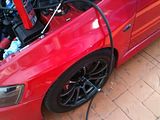
Breather hose routed into car so that expelling air from the v.c would not disrupt my tests

My boost leak tester
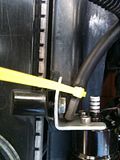
Plug up Mbc pressure source source, if not you'll hear a nice leak out of the mbc.
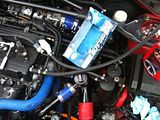
Showing breather hose

My Compressor

Purchased replacement o-rings for another major leak found there today. I purchased a omni 4 bar map sensor and re-used the oem o-ring because it has more meat, however, they both fail. Purchased a beefier set a DiscountAutoParts...leak fixed.
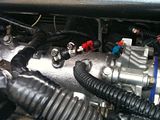
Capped these guys off due to lack of use. I need to find a more permanent solution, i dyno'd with an older set with torn rubber(major boost leaks)
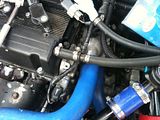
4 ft hose leading away from valve cover(never plug valve cover)
Here are pics of my setup.(CLICK IMAGES TO MAKE LARGER)

Breather hose routed into car so that expelling air from the v.c would not disrupt my tests

My boost leak tester

Plug up Mbc pressure source source, if not you'll hear a nice leak out of the mbc.

Showing breather hose

My Compressor


Purchased replacement o-rings for another major leak found there today. I purchased a omni 4 bar map sensor and re-used the oem o-ring because it has more meat, however, they both fail. Purchased a beefier set a DiscountAutoParts...leak fixed.

Capped these guys off due to lack of use. I need to find a more permanent solution, i dyno'd with an older set with torn rubber(major boost leaks)

4 ft hose leading away from valve cover(never plug valve cover)
#9
Newbie
iTrader: (1)
Join Date: Mar 2007
Location: Worcester, MA
Posts: 43
Likes: 0
Received 0 Likes
on
0 Posts
Great thread. I just picked up an EVO and this was the first test I wanted to run on it before I start getting into the tuning end of it. I like the 4x3 fernco idea with the pvc adapter. I probably have that stuff lying around the house.
#10
Evolving Member
iTrader: (8)
Join Date: Jan 2009
Location: Albany,NY
Posts: 186
Likes: 0
Received 0 Likes
on
0 Posts
Just checked mine. Leaky LICP (T-Bolt clamps doesn't mean no leak), small rip in pvc hose, and leaking injector orings.
Pays to check em. Once you have the tester made it only takes a few minutes to do.
Pays to check em. Once you have the tester made it only takes a few minutes to do.
#11
Newbie
iTrader: (1)
Join Date: Mar 2007
Location: Worcester, MA
Posts: 43
Likes: 0
Received 0 Likes
on
0 Posts
I performed this test yesterday but I had a few different thing to add. I performed this test with an Injen intake on the car. I pulled the filter off just behind the MAF and used a 3" Cast / plastic to 3" copper sized mission coupling. The copper side is smaller and fits dirrectly on the intake tube. The problem I did find was that the Injen intake has no flange on the end of the pipe so the pressure test setup wanted to keep popping off. That will raise your blood pressure if your not careful. I got enought pressure in the system to find a good sized leak from the TB shaft though. Gotta get some Milspec seals now.
If I make another setup I would probably go straight to the turbo so I have a lip to grab onto without popping off of it at 25psi.
If I make another setup I would probably go straight to the turbo so I have a lip to grab onto without popping off of it at 25psi.

#13
Former Sponsor
iTrader: (74)
Join Date: Mar 2008
Location: miami florida
Posts: 1,640
Likes: 0
Received 0 Likes
on
0 Posts
i just did a test on a car and noticed ididnt make not even 2psi , from a huge compressor i used , all the air is coming out thru the exhaust catback , nothing is leaking from the pipes all shoots out thru the muffler
#14
Evolved Member
iTrader: (24)
Join Date: Oct 2007
Location: Ft. Lauderdale, Florida
Posts: 1,005
Likes: 0
Received 0 Likes
on
0 Posts
everytime i try to test my car i do it the same way as everyone has mentioned above, with capping off the mbc yada yada and i couldnt get more then 2 psi into my ssytem and thats using a shop compressor, since i was running open dp i checked to see if any was leaking out the exhaust and noticed some leaking out of the dp so i blocked it off with a shirt and i got to 14psi... is that supposed to happen, does the motor have to be at TDC?

